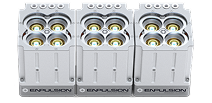Verification of the Thrust Vectoring Capability of a FEEP Thruster Using Spatial Plasma Plume Diagnostic Measurements
Abstract:
The ENPULSION NANO AR3 thruster is a liquid metal Field Emission Electric Propulsion (FEEP) thruster with thrust vectoring capability without moving parts. It was recently developed in close cooperation between ENPULSION and FOTEC. The thruster is based on the significant flight heritage of the ENPUSLION NANO thruster, generating thrust by electrostatically extracting and accelerating Indium ions from Taylor cones established on the needle tips of a porous, crown-shaped emitter suspended with liquified Indium as propellant. In the NANO AR3, a segmented counter-electrode is used to apply differential electric potentials, resulting in varying electric fields in different regions of the ion emitter, which allows to perform relative throttling of the ion current emitted at different regions of the ion current. As the total thrust generated by the emitter is a superposition of the individual beamlets, this differential throttling of different regions of the ring-shaped ion emitter allows for effectively control the thrust vector of the thruster system. The NANO AR3 is a fully packaged propulsion system including propellant tank and power electronics to achieve the required high voltages and control thereof, providing 350uN at variable specific impulse and a maximum power draw of 45W. An algorithm to translate commanded thrust vector offset angles to the applied high voltage potentials of the emitter and different extractor sections is autonomously controlling the system to achieve the commanded thrust level and vectoring angles. This paper describes beam diagnostics measurements performed at FOTEC using their FEEP ion beam diagnostics facility in LIFET-4. The diagnostics system consists of a remotely controlled semi-circular rotating arm equipped with 23 Faraday cups. These are used to measure the spatial ion current density distribution of the thruster beam. The specially designed digital Faraday cups feature adjacent electronics to reduce strongly reduce signal noise. The paper will provide a description of the ion beam diagnostics system used, as well as the thruster assembled in the test setup.



